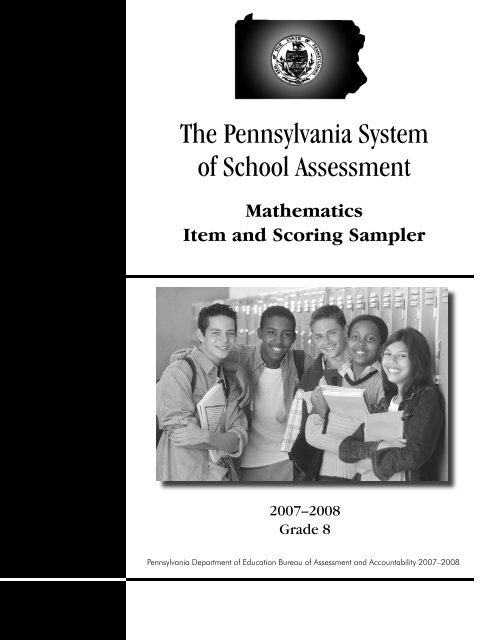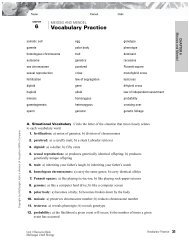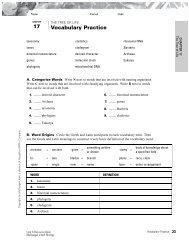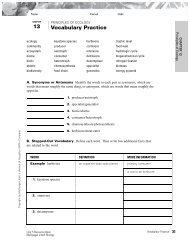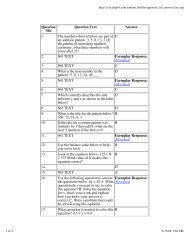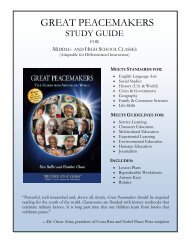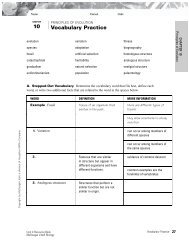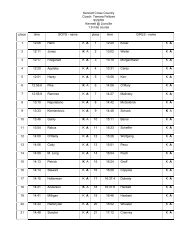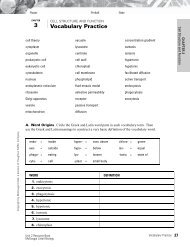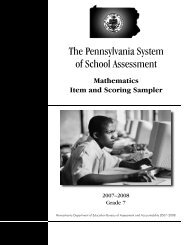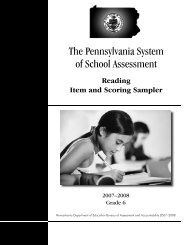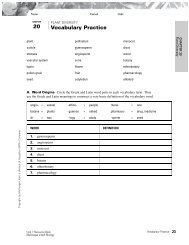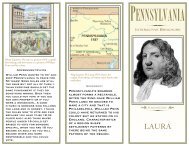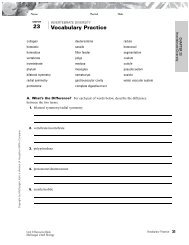2007-2008 Grade 8 Mathematics Item and Scoring Sampler
2007-2008 Grade 8 Mathematics Item and Scoring Sampler
2007-2008 Grade 8 Mathematics Item and Scoring Sampler
Create successful ePaper yourself
Turn your PDF publications into a flip-book with our unique Google optimized e-Paper software.
The Pennsylvania System<br />
of School Assessment<br />
<strong>Mathematics</strong><br />
<strong>Item</strong> <strong>and</strong> <strong>Scoring</strong> <strong>Sampler</strong><br />
<strong>2007</strong>–<strong>2008</strong><br />
<strong>Grade</strong> 8<br />
Pennsylvania Department of Education Bureau of Assessment <strong>and</strong> Accountability <strong>2007</strong>–<strong>2008</strong>
TABLE OF CONTENTS<br />
Introduction . . . . . . . . . . . . . . . . . . . . . . . . . . . . . . . . . . . . . . . . . . . . . . . . . . . . . . . . . . . . . . . . . . . 1<br />
General Description of <strong>Mathematics</strong> <strong>Scoring</strong> Guidelines . . . . . . . . . . . . . . . . . . . . . . . . . . . . . 2<br />
<strong>Mathematics</strong> Reporting Categories . . . . . . . . . . . . . . . . . . . . . . . . . . . . . . . . . . . . . . . . . . . . . . . . 3<br />
Description of Sample <strong>Item</strong>s . . . . . . . . . . . . . . . . . . . . . . . . . . . . . . . . . . . . . . . . . . . . . . . . . . . . . 3<br />
Formula Sheet. . . . . . . . . . . . . . . . . . . . . . . . . . . . . . . . . . . . . . . . . . . . . . . . . . . . . . . . . . . . . . . . . . 4<br />
Multiple-Choice <strong>Item</strong>s. . . . . . . . . . . . . . . . . . . . . . . . . . . . . . . . . . . . . . . . . . . . . . . . . . . . . . . . . . . 5<br />
First Open-Ended <strong>Item</strong> . . . . . . . . . . . . . . . . . . . . . . . . . . . . . . . . . . . . . . . . . . . . . . . . . . . . . . . . . 16<br />
<strong>Item</strong>-Specific <strong>Scoring</strong> Guideline . . . . . . . . . . . . . . . . . . . . . . . . . . . . . . . . . . . . . . . . . . . . . . 18<br />
Open-Ended <strong>Item</strong> Responses. . . . . . . . . . . . . . . . . . . . . . . . . . . . . . . . . . . . . . . . . . . . . . . . . 20<br />
Second Open-Ended <strong>Item</strong>. . . . . . . . . . . . . . . . . . . . . . . . . . . . . . . . . . . . . . . . . . . . . . . . . . . . . . . 36<br />
<strong>Item</strong>-Specific <strong>Scoring</strong> Guideline . . . . . . . . . . . . . . . . . . . . . . . . . . . . . . . . . . . . . . . . . . . . . . 38<br />
Open-Ended <strong>Item</strong> Responses. . . . . . . . . . . . . . . . . . . . . . . . . . . . . . . . . . . . . . . . . . . . . . . . . 40<br />
<strong>Grade</strong> 8 <strong>Mathematics</strong> <strong>Item</strong> <strong>Sampler</strong> <strong>2007</strong>–<strong>2008</strong><br />
i
MATHEMATICS<br />
INTRODUCTION<br />
General Introduction<br />
The Department of Education provides districts <strong>and</strong> schools with tools to assist in delivering focused instructional<br />
programs aligned to the state assessment system. These tools include assessment anchor documents, assessment<br />
h<strong>and</strong>books, <strong>and</strong> content-based item <strong>and</strong> scoring samplers. This <strong>2007</strong>–<strong>2008</strong> <strong>Mathematics</strong> <strong>Item</strong> <strong>and</strong> <strong>Scoring</strong> <strong>Sampler</strong> is a<br />
useful tool for Pennsylvania educators in the preparation of local instructional programs <strong>and</strong> the statewide PSSA.<br />
What Is Included<br />
This item <strong>and</strong> scoring sampler contains mathematics multiple-choice items <strong>and</strong> open-ended items that have been<br />
written to align to the <strong>2007</strong> Assessment Anchor Content St<strong>and</strong>ards (Assessment Anchors). Some of the items are<br />
actual items used to assess student performance on the PSSA. They provide an idea of the types of items that will<br />
appear on the operational Spring <strong>2008</strong> PSSA. Each item has been through a rigorous review process to ensure<br />
alignment with the Assessment Anchors.<br />
Purpose <strong>and</strong> Uses<br />
The items in this sampler may be used as examples for creating assessment items at the classroom level, <strong>and</strong> they may<br />
also be copied <strong>and</strong> used as part of a local instructional program.* Classroom teachers may find it beneficial to have<br />
students respond to the open-ended items in this sampler. Educators can then use the sampler as a guide to score the<br />
responses either independently or together with colleagues within a school or district.<br />
<strong>Item</strong> Format <strong>and</strong> <strong>Scoring</strong> Guidelines<br />
The multiple-choice items have four answer choices. Each correct response to a multiple-choice item is worth<br />
one point.<br />
Each open-ended item is designed to take about ten minutes to complete. During an actual testing event, students are<br />
given additional time as necessary to complete the test items. The open-ended items in mathematics are scored with<br />
item-specific scoring guides on a 0–4 point scale. An item-specific scoring guide with examples of student responses<br />
for each score point is presented with each item.<br />
Also included is the General Description of <strong>Mathematics</strong> <strong>Scoring</strong> Guidelines used to develop the item-specific<br />
guidelines. The General <strong>Scoring</strong> Guidelines should be used to develop any item-specific scoring guidelines created for<br />
use within local instructional programs.*<br />
<strong>Item</strong> Alignment<br />
All PSSA items are aligned to statements <strong>and</strong> specifications included in the Assessment Anchor Content St<strong>and</strong>ards<br />
documents. The mathematics content included in the PSSA mathematics multiple-choice items will align with the<br />
Assessment Anchors as defined by the Eligible Content statements. The process skills, directives, <strong>and</strong> action statements<br />
will also specifically align with the Assessment Anchors as defined by Eligible Content statements.<br />
The mathematics content included in the PSSA mathematics open-ended items will align with content included<br />
in Eligible Content statements. The process skills, directives, <strong>and</strong> action statements included in the performance<br />
dem<strong>and</strong>s of the PSSA mathematics open-ended items will align with specifications included in the Assessment Anchor<br />
statements, the Descriptor statements, <strong>and</strong>/or the Eligible Content statements. In other words, the verbs or action<br />
statements used in the open-ended questions or stems can come from the Eligible Content, Descriptor, or Anchor.<br />
* The permission to copy <strong>and</strong>/or use these materials does not extend to commercial purposes.<br />
<strong>Grade</strong> 8 <strong>Mathematics</strong> <strong>Item</strong> <strong>Sampler</strong> <strong>2007</strong>–<strong>2008</strong><br />
1
MATHEMATICS<br />
GENERAL DESCRIPTION OF MATHEMATICS SCORING GUIDELINES<br />
4 – The response demonstrates a thorough underst<strong>and</strong>ing of the mathematical concepts <strong>and</strong> procedures<br />
required by the task.<br />
The response provides correct answer(s) with clear <strong>and</strong> complete mathematical procedures shown <strong>and</strong> a correct<br />
explanation, as required by the task. Response may contain a minor “blemish” or omission in work or explanation<br />
that does not detract from demonstrating a thorough underst<strong>and</strong>ing.<br />
3 – The response demonstrates a general underst<strong>and</strong>ing of the mathematical concepts <strong>and</strong> procedures<br />
required by the task.<br />
The response <strong>and</strong> explanation (as required by the task) are mostly complete <strong>and</strong> correct. The response may have<br />
minor errors or omissions that do not detract from demonstrating a general underst<strong>and</strong>ing.<br />
2 – The response demonstrates a partial underst<strong>and</strong>ing of the mathematical concepts <strong>and</strong> procedures<br />
required by the task.<br />
The response is somewhat correct with partial underst<strong>and</strong>ing of the required mathematical concepts <strong>and</strong>/or<br />
procedures demonstrated <strong>and</strong>/or explained. The response may contain some work that is incomplete or unclear.<br />
1 – The response demonstrates a minimal underst<strong>and</strong>ing of the mathematical concepts <strong>and</strong> procedures<br />
required by the task.<br />
0 – The response has no correct answer <strong>and</strong> insufficient evidence to demonstrate any underst<strong>and</strong>ing of the<br />
mathematical concepts <strong>and</strong> procedures as required by the task for that grade level.<br />
Response may show only information copied from the question.<br />
Special Categories within zero reported separately:<br />
BLK (blank) ...........Blank, entirely erased, or written refusal to respond<br />
OT ..........................Off task<br />
IL ...........................Illegible<br />
LOE .......................Response in a language other than English<br />
<strong>Grade</strong> 8 <strong>Mathematics</strong> <strong>Item</strong> <strong>Sampler</strong> <strong>2007</strong>–<strong>2008</strong> 2
MATHEMATICS<br />
MATHEMATICS REPORTING CATEGORIES<br />
<strong>Mathematics</strong> scores are reported in five categories:<br />
A – Numbers <strong>and</strong> Operations<br />
B – Measurement<br />
C – Geometry<br />
D – Algebraic Concepts<br />
E – Data Analysis <strong>and</strong> Probability<br />
Examples of multiple-choice <strong>and</strong> open-ended items assessing these categories are included in this booklet.<br />
DESCRIPTION OF SAMPLE ITEMS<br />
The mathematics multiple-choice items begin on page 5. Each item is preceded by the Assessment Anchor <strong>and</strong> Eligible<br />
Content coding. The majority of answer options A–D are followed by a brief analysis or rationale. The correct answer<br />
is indicated by an asterisk (*).<br />
Two open-ended items follow the multiple-choice items. Each of these is displayed with an item-specific scoring guide<br />
<strong>and</strong> examples of responses with scores <strong>and</strong> annotations.<br />
A calculator is permitted for use in solving items numbered 4–27 in this sampler. <strong>Item</strong>s numbered 1–3 are to be solved<br />
without the use of a calculator. Scratch paper may be used in solving all items.<br />
<strong>Grade</strong> 8 <strong>Mathematics</strong> <strong>Item</strong> <strong>Sampler</strong> <strong>2007</strong>–<strong>2008</strong> 3
MATHEMATICS<br />
FORMULA SHEET<br />
Formulas that you may need to work questions are found below.<br />
You may use calculator Õ or the number 3.14.<br />
<strong>2008</strong><br />
<strong>Grade</strong> 8<br />
w<br />
P 2l + 2w<br />
A lw<br />
a<br />
c<br />
Pythagorean Theorem :<br />
a 2 b 2 c 2<br />
l<br />
b<br />
h<br />
A bh<br />
Distance :<br />
d rt<br />
b<br />
Simple Interest :<br />
l prt<br />
a<br />
b<br />
h<br />
A 1 h(a b)<br />
2<br />
Degrees in a 3 to 8 sided figure :<br />
Sum of angle measures 180(n 2),<br />
where n number of sides<br />
Temperature Conversions :<br />
c<br />
b<br />
h<br />
d<br />
P b c d<br />
A 1 2 bh<br />
C F <br />
F<br />
Customary Conversions :<br />
1 mile = 5,280 feet (ft)<br />
1 yard (yd) = 3 feet<br />
1 foot = 12 inches (in.)<br />
C <br />
<br />
r<br />
s<br />
s<br />
C 2r<br />
A r 2<br />
SA 6s 2<br />
V s s s<br />
1 ton (T) = 2,000 pounds (lb)<br />
1 pound = 16 ounces (oz.)<br />
1 gallon (gal) = 4 quarts (qt)<br />
1 quart = 2 pints (pt)<br />
1pint=2cups(c)<br />
1 cup = 8 fluid ounces<br />
1 day = 24 hours (hr)<br />
1 hour = 60 minutes (min)<br />
1 minute = 60 seconds (sec)<br />
s<br />
l<br />
w<br />
h<br />
SA 2lw 2lh 2wh<br />
V lwh<br />
Metric Conversions :<br />
1 kilometer = 1000 meters<br />
1 hectometer = 100 meters<br />
1 dekameter = 10 meters<br />
1 meter<br />
1 decimeter = 0.1 meter<br />
1 centimeter = 0.01 meter<br />
1 millimeter = 0.001 meter<br />
<strong>Grade</strong> 8 <strong>Mathematics</strong> <strong>Item</strong> <strong>Sampler</strong> <strong>2007</strong>–<strong>2008</strong> 4
MATHEMATICS<br />
MULTIPLE-CHOICE ITEMS<br />
During an assessment, students would not be permitted to use a calculator on items 1–3.<br />
A.2.1.1<br />
1. Simplify: 8 • 3 2 + 7 • (6 ] 4)<br />
A.3.3.1<br />
3. Multiply:<br />
41-7433<br />
A 62 3 2 = 6<br />
B 86 *<br />
C 110 (8 × 9) + (7 • 6) – 4<br />
D 590 (8 × 3) 2<br />
A 12.48<br />
41.6 × 3<br />
incorrect decimal point<br />
placement<br />
B 123.18 0.6 × 3 = 0.18 with no regroup<br />
C 124.8 *<br />
A.3.2.1<br />
2. Jim earned $127.59 last month. He<br />
spent about 20% of the money. Which<br />
is the closest estimate of the amount of<br />
money Jim spent?<br />
8MSA331<br />
D 1231.8 0.6 × 3 = 1.8 with no regroup<br />
41-7283<br />
A $13 10% of $130<br />
B $20 20% of $100<br />
C $26 *<br />
D $30 20% of $150<br />
<strong>Grade</strong> 8 <strong>Mathematics</strong> <strong>Item</strong> <strong>Sampler</strong> <strong>2007</strong>–<strong>2008</strong> 5
MATHEMATICS<br />
A.1.1.1<br />
4. Which is 5,291,000 written in scientific<br />
notation?<br />
A.3.1.2<br />
6. Mara has $100. She wants to buy 3 pieces<br />
of luggage priced as shown below.<br />
41-7293<br />
A 5.291 3 10 3<br />
exponent equals number of zeros<br />
B 529.1 3 10 4<br />
incorrect placement of decimal point<br />
C 52.91 3 10 5<br />
incorrect placement of decimal point<br />
D 5.291 3 10 6<br />
*<br />
•<br />
•<br />
•<br />
suitcase $39.95<br />
carry-on bag $24.95<br />
tote bag $16.95<br />
When is an estimate appropriate?<br />
A<br />
B<br />
when Mara is deciding if $100 is<br />
enough to buy all 3 pieces<br />
*<br />
when the salesperson is scanning the<br />
cost of each piece<br />
exact amount<br />
A.3.1.1<br />
5. Lisa needs 56 envelopes. She buys the<br />
envelopes in packages of 12. What is the<br />
minimum number of packages Lisa should<br />
buy to get 56 envelopes?<br />
8MSA311<br />
A 3 56 rounded to 60 <strong>and</strong> 12 to 20; 60 4 20<br />
B 4 56 4 12; rounded<br />
C 5 *<br />
D 6 56 rounded to 60 <strong>and</strong> 12 to 10; 60 4 10<br />
C<br />
D<br />
8MSA312<br />
when Mara is told how much money<br />
is due<br />
exact amount<br />
when the salesperson is counting out<br />
Mara’s change<br />
exact amount<br />
<strong>Grade</strong> 8 <strong>Mathematics</strong> <strong>Item</strong> <strong>Sampler</strong> <strong>2007</strong>–<strong>2008</strong> 6
MATHEMATICS<br />
B.1.1.3<br />
7. Danny babysat for 5 hours yesterday. For<br />
how many seconds did Danny babysit<br />
yesterday?<br />
A 300 minutes, 5 × 60<br />
B 3,600 seconds in 1 hour, 60 × 60<br />
C 7,200 minutes in 5 days, 5 × 24 × 60<br />
B.2.1.3<br />
9. The sum of the measures of the interior<br />
angles of a polygon is 9008. Exactly how<br />
many sides does the polygon have?<br />
8MSB213<br />
A 3 900 4 180 – 2<br />
B 5 900 4 180<br />
C 7 *<br />
D 10 900 4 180 × 2<br />
8MSB113<br />
D 18,000 *<br />
B.1.1.4<br />
8. The thermometer in Molly’s backyard<br />
read 21°F. What was the approximate<br />
temperature in degrees Celsius?<br />
41-0141<br />
A –20.3°C (5/9)(21) – 32<br />
B –6.1°C *<br />
C 11.6°C (5/9)(21)<br />
D 69.8°C (9/5)21 + 32<br />
<strong>Grade</strong> 8 <strong>Mathematics</strong> <strong>Item</strong> <strong>Sampler</strong> <strong>2007</strong>–<strong>2008</strong> 7
MATHEMATICS<br />
C.1.1.1<br />
10. A cone is shown below.<br />
Which is a net for the cone?<br />
A<br />
B<br />
*<br />
C<br />
D<br />
8MSC111<br />
<strong>Grade</strong> 8 <strong>Mathematics</strong> <strong>Item</strong> <strong>Sampler</strong> <strong>2007</strong>–<strong>2008</strong> 8
MATHEMATICS<br />
C.1.1.2<br />
11. Angles J <strong>and</strong> K are vertical angles. The<br />
measure of angle J is 468. What is the<br />
measure of angle K?<br />
C.1.1.3<br />
12. In the diagram below, line l is parallel<br />
to line m <strong>and</strong> line p is parallel to line q.<br />
A 448 complement<br />
B 468 *<br />
C 1348 supplement<br />
2<br />
3<br />
4 5<br />
1<br />
p<br />
q<br />
8MSC112<br />
D 1368 468 + 908<br />
l<br />
Which angle has the same measure<br />
as /1?<br />
m<br />
41-7321<br />
A /2 supplement<br />
B /3 *<br />
C /4 supplement<br />
D /5 supplement<br />
<strong>Grade</strong> 8 <strong>Mathematics</strong> <strong>Item</strong> <strong>Sampler</strong> <strong>2007</strong>–<strong>2008</strong> 9
MATHEMATICS<br />
C.3.1.1<br />
Use the graph below to answer question 13.<br />
7<br />
6<br />
5<br />
4<br />
3<br />
2<br />
1<br />
−7−6−5−4−3 −2−1 −1<br />
−2<br />
−3<br />
−4<br />
−5<br />
−6<br />
−7<br />
y<br />
1 2 3 4 5 6 7<br />
x<br />
D.1.1.1<br />
14. Fiona created a pattern using numbers as<br />
shown below.<br />
8MSD111<br />
0, 2, 6, 12<br />
The pattern continues. What is the next<br />
number in the pattern?<br />
A 14 0 + 2 = 2; 12 + 2 = 14<br />
B 18 6 + 6 = 12; 12 + 6 = 18<br />
C 20 *<br />
D 24 6 × 2 = 12; 12 × 2 = 24<br />
13. At what point does the line intersect<br />
the y -axis?<br />
41-0120<br />
A ( _ 3, 0) reverse order<br />
B (0, _ 3) *<br />
C (0, 5) reverse order of x-intercept<br />
D (5, 0) x-intercept<br />
D.1.1.2<br />
15. At 3:00 P.M. the temperature in<br />
Pittsburgh was 938F. The temperature<br />
decreased at a rate of 28F every<br />
30 minutes. What was the temperature<br />
at 7:30 P.M.?<br />
A 758F *<br />
B 778F 93 ] (2 × 8)<br />
41-0711<br />
C 848F 93 ] (2 × 4.5)<br />
D 1118F 93 + (2 × 9)<br />
<strong>Grade</strong> 8 <strong>Mathematics</strong> <strong>Item</strong> <strong>Sampler</strong> <strong>2007</strong>–<strong>2008</strong> 10
MATHEMATICS<br />
D.2.1.1<br />
16. Dora owns a card store. After a full<br />
week, she made $250.00 by selling<br />
cards (c). Using the equation<br />
1.25c = 250, how many cards did Dora<br />
sell that week?<br />
A 125 250 ] 125<br />
B 200 *<br />
C 251 250 + 1<br />
D.2.2.1<br />
18. Which expression represents 4 times<br />
the sum of x squared <strong>and</strong> 6?<br />
41-7364<br />
A 4x 2 + 6 4 distributed to first term only<br />
B 4(x 2 + 6) *<br />
C 4(x + 6) 2 quantity squared<br />
D (4x + 6) 2 entire expression squared<br />
41-7447<br />
D 312 250 × 1.25<br />
D.2.1.2<br />
17. In which equation is m = 28 the solution?<br />
A<br />
m<br />
}<br />
5 – 3 = 5 m = 40<br />
B m – 3 }<br />
5 = 5 m = 5 3 }<br />
5<br />
C<br />
m – 3<br />
} = 5 *<br />
5<br />
8MSD212<br />
D (m – 3)5 = 5 m = 4<br />
<strong>Grade</strong> 8 <strong>Mathematics</strong> <strong>Item</strong> <strong>Sampler</strong> <strong>2007</strong>–<strong>2008</strong> 11
MATHEMATICS<br />
D.4.1.1<br />
Use the table below to answer question 19.<br />
x<br />
3<br />
6<br />
9<br />
12<br />
y<br />
11<br />
17<br />
23<br />
29<br />
19. Which graph shows the relationship?<br />
A<br />
y<br />
12<br />
10<br />
8<br />
6<br />
4<br />
2<br />
B<br />
12<br />
10<br />
8<br />
6<br />
4<br />
2<br />
–12–10 –8 –6–4<br />
–2 –2<br />
–4<br />
–6<br />
–8<br />
–10<br />
–12<br />
2 4 6 8 1012<br />
x<br />
x<br />
–12–10 –8 –6–4<br />
–2 –2<br />
2 4 6 8 1012<br />
–4<br />
–6<br />
–8<br />
–10<br />
–12<br />
slope <strong>and</strong> y-intercept interchanged<br />
x <strong>and</strong> y values reversed<br />
y<br />
y<br />
y<br />
C<br />
12<br />
10<br />
8<br />
6<br />
4<br />
2<br />
–12–10 –8 –6–4<br />
–2 –2<br />
2 4 6 8 1012<br />
–4<br />
–6<br />
–8<br />
–10<br />
–12<br />
x<br />
D<br />
12<br />
10<br />
8<br />
6<br />
4<br />
2<br />
–12–10 –8 –6–4<br />
–2 –2<br />
2 4 6 8 1012<br />
–4<br />
–6<br />
–8<br />
–10<br />
–12<br />
x<br />
8MSD411<br />
(3, 11) plotted with slope of 3<br />
*<br />
<strong>Grade</strong> 8 <strong>Mathematics</strong> <strong>Item</strong> <strong>Sampler</strong> <strong>2007</strong>–<strong>2008</strong> 12
MATHEMATICS<br />
D.4.1.3<br />
20. The table below shows a relationship<br />
between the values of x <strong>and</strong> y.<br />
41-7268<br />
x<br />
y<br />
–5 –9<br />
–2 –6<br />
1 –3<br />
2 –2<br />
4 0<br />
Which equation describes the<br />
relationship?<br />
A y = ]2x ] 1 x = 1; y = ] 3 (3rd row)<br />
B y = ]x + 4 x = 4; y = 0 (5th row)<br />
C y = x ] 4 *<br />
D y = 2x ] 5 x = 1; y = ] 3 (3rd row)<br />
E.1.1.1<br />
21. A student surveyed his classmates<br />
about their favorite choice for a field<br />
trip. The results of the survey are<br />
shown below.<br />
41-2429<br />
21% art gallery<br />
15% museum<br />
16% theater<br />
48% zoo<br />
Which of these displays would best<br />
represent the data?<br />
A line graph 2 variables<br />
B circle graph *<br />
C frequency table tally list<br />
D box-<strong>and</strong>-whiskers plot data list<br />
<strong>Grade</strong> 8 <strong>Mathematics</strong> <strong>Item</strong> <strong>Sampler</strong> <strong>2007</strong>–<strong>2008</strong> 13
MATHEMATICS<br />
E.1.1.2<br />
22. The graph below shows the frequency of<br />
days that were sunny, cloudy, rainy, <strong>and</strong><br />
snowy in February of 2005.<br />
February 2005<br />
E.3.2.1<br />
23. Matt has three pairs of shorts,<br />
five shirts, <strong>and</strong> two pairs of shoes.<br />
How many different outfits consisting<br />
of one shirt, one pair of shorts, <strong>and</strong><br />
one pair of shoes can he make?<br />
rainy<br />
snowy<br />
sunny<br />
cloudy<br />
41-0379<br />
A 5 number of shirts<br />
B 10 3 + 5 + 2<br />
C 25 5 × (3 + 2)<br />
D 30 *<br />
Which statement about the data is true?<br />
A<br />
B<br />
C<br />
D<br />
It was sunny the same number of days<br />
as it was rainy.<br />
sunny section larger than rainy<br />
It was snowy the same number of<br />
days as it was rainy.<br />
*<br />
It was sunny more days than it was<br />
cloudy.<br />
cloudy section larger than sunny<br />
It was snowy more days than it was<br />
sunny.<br />
sunny section larger than snowy<br />
8MSE112<br />
<strong>Grade</strong> 8 <strong>Mathematics</strong> <strong>Item</strong> <strong>Sampler</strong> <strong>2007</strong>–<strong>2008</strong> 14
MATHEMATICS<br />
E.4.1.1<br />
Use the scatterplot below to answer<br />
question 24.<br />
Height (ft)<br />
9<br />
8<br />
7<br />
6<br />
5<br />
4<br />
3<br />
2<br />
1<br />
Weight <strong>and</strong> Height of 25 People<br />
y<br />
25 50 75 100 125 150 175 200 225<br />
Weight (lbs)<br />
24. Which type of correlation is represented<br />
by the scatterplot?<br />
x<br />
E.4.1.2<br />
25. A r<strong>and</strong>om survey shows that 14 out of<br />
21 students plan to vote for Jacob for<br />
class president. Which is the best<br />
prediction of the total number of votes<br />
Jacob will receive if 180 students vote?<br />
41-7277<br />
A 35 14 + 21<br />
B 90 180 ÷ 2<br />
C 120 *<br />
D 173 180 – (21 – 14)<br />
41-0051<br />
A<br />
B<br />
C<br />
D<br />
strong positive<br />
*<br />
strong negative<br />
opposite direction<br />
weak positive<br />
incorrect relation of points<br />
weak negative<br />
opposite direction; incorrect relation<br />
<strong>Grade</strong> 8 <strong>Mathematics</strong> <strong>Item</strong> <strong>Sampler</strong> <strong>2007</strong>–<strong>2008</strong> 15
MATHEMATICS<br />
FIRST OPEN-ENDED ITEM<br />
D.2<br />
26. Some students held a car wash. They charged $3 to wash each car. The students made<br />
a profit of $181 after they spent $11 on supplies for the car wash.<br />
A. How many cars did they wash? Show all your work. Explain why you did<br />
each step.<br />
41-7332<br />
GO TO THE NEXT PAGE TO FINISH THE QUESTION.<br />
<strong>Grade</strong> 8 <strong>Mathematics</strong> <strong>Item</strong> <strong>Sampler</strong> <strong>2007</strong>–<strong>2008</strong> 16
MATHEMATICS<br />
26. Continued. Please refer to the previous page for task explanation.<br />
B. What is the least number of cars the students must wash to have a profit of<br />
$330 after spending a total of $15 on supplies? Show all your work. Explain<br />
why you did each step.<br />
41-7332<br />
<strong>Grade</strong> 8 <strong>Mathematics</strong> <strong>Item</strong> <strong>Sampler</strong> <strong>2007</strong>–<strong>2008</strong> 17
MATHEMATICS<br />
ITEM-SPECIFIC SCORING GUIDELINE<br />
<strong>Item</strong> #26<br />
This item will be reported under Category D, Algebraic Concepts.<br />
Assessment Anchor:<br />
D.2–Represent <strong>and</strong>/or analyze mathematical situations using numbers, symbols, words, tables, <strong>and</strong>/or graphs.<br />
Specific Eligible Content addressed by this item:<br />
D.2.2.2–Write <strong>and</strong>/or solve an equation for a given problem situtation (one variable only).<br />
<strong>Scoring</strong> Guide:<br />
Score<br />
4<br />
3<br />
2<br />
1<br />
0<br />
Nonscorable<br />
In response to this item, the student—<br />
demonstrates a thorough underst<strong>and</strong>ing of how to write <strong>and</strong> solve an equation for<br />
a given problem situation (one variable only) by correctly solving problems <strong>and</strong><br />
clearly explaining procedures.<br />
demonstrates a general underst<strong>and</strong>ing of how to write <strong>and</strong> solve an equation for<br />
a given problem situation (one variable only) by correctly solving problems <strong>and</strong><br />
clearly explaining procedures with only minor errors or omissions.<br />
demonstrates a partial underst<strong>and</strong>ing of how to write <strong>and</strong> solve an equation for a<br />
given problem situation (one variable only) by correctly performing a significant<br />
portion of the required task.<br />
demonstrates minimal underst<strong>and</strong>ing of how to write <strong>and</strong> solve an equation for a<br />
given problem situation (one variable only).<br />
The response has no correct answer <strong>and</strong> insufficient evidence to demonstrate any<br />
underst<strong>and</strong>ing of the mathematical concepts <strong>and</strong> procedures as required by the<br />
task. Response may show only information copied from the question.<br />
BLK (blank) .............. Blank, entirely erased, or written refusal to respond<br />
OT ............................. Off task<br />
IL ............................... Illegible<br />
LOE ........................... Response in a language other than English<br />
<strong>Grade</strong> 8 <strong>Mathematics</strong> <strong>Item</strong> <strong>Sampler</strong> <strong>2007</strong>–<strong>2008</strong> 18
MATHEMATICS<br />
<strong>Item</strong> #26<br />
Top <strong>Scoring</strong> Response:<br />
Part A Answer<br />
64 (cars)<br />
Support<br />
3c ] 11 = 181<br />
3c ] 11 + 11 = 181 + 11<br />
3c = 192<br />
3c<br />
}<br />
3 = 192 }<br />
3<br />
c = 64<br />
AND<br />
Sample Explanation:<br />
To find the number of cars washed I added the money spent to the profit<br />
to find out how much money they really collected. Then I divided by 3<br />
(charge per car) to find out how many cars they washed.<br />
OR equivalent<br />
(2 score points)<br />
0.5 point for correct answer<br />
1.5 points for complete support<br />
Part B Answer<br />
115 (cars)<br />
Support<br />
3c ] 15 = 330<br />
3c ] 15 + 15 = 330 + 15<br />
3c = 345<br />
3c<br />
}<br />
3 = 345 }<br />
3<br />
c = 115<br />
AND<br />
Sample Explanation:<br />
To find the number of cars washed I added the money spent to the profit to<br />
find out how much money they really collected. Then I divided by 3<br />
(charge per car) to find out how many cars they washed.<br />
OR equivalent<br />
(2 score points)<br />
0.5 point for correct answer<br />
1.5 points for complete support<br />
<strong>Grade</strong> 8 <strong>Mathematics</strong> <strong>Item</strong> <strong>Sampler</strong> <strong>2007</strong>–<strong>2008</strong> 19
OPEN-ENDED ITEM RESPONSES<br />
D.2 Response Score: 4<br />
MATHEMATICS<br />
26. Some students held a car wash. They charged $3 to wash each car. The students made<br />
a profit of $181 after they spent $11 on supplies for the car wash.<br />
A. How many cars did they wash? Show all your work. Explain why you did<br />
each step.<br />
The student has given the correct answer.<br />
The student has shown complete support.<br />
41-7332<br />
GO TO THE NEXT PAGE TO FINISH THE QUESTION.<br />
<strong>Grade</strong> 8 <strong>Mathematics</strong> <strong>Item</strong> <strong>Sampler</strong> <strong>2007</strong>–<strong>2008</strong> 20
MATHEMATICS<br />
26. Continued. Please refer to the previous page for task explanation.<br />
B. What is the least number of cars the students must wash to have a profit of<br />
$330 after spending a total of $15 on supplies? Show all your work. Explain<br />
why you did each step.<br />
41-7332<br />
The student has given the correct answer.<br />
The student has shown complete support.<br />
<strong>Grade</strong> 8 <strong>Mathematics</strong> <strong>Item</strong> <strong>Sampler</strong> <strong>2007</strong>–<strong>2008</strong> 21
MATHEMATICS<br />
D.2 Response Score: 3<br />
26. Some students held a car wash. They charged $3 to wash each car. The students made<br />
a profit of $181 after they spent $11 on supplies for the car wash.<br />
A. How many cars did they wash? Show all your work. Explain why you did<br />
each step.<br />
The student has given the correct answer.<br />
The student has shown all correct work.<br />
The student did not give an explanation.<br />
41-7332<br />
GO TO THE NEXT PAGE TO FINISH THE QUESTION.<br />
<strong>Grade</strong> 8 <strong>Mathematics</strong> <strong>Item</strong> <strong>Sampler</strong> <strong>2007</strong>–<strong>2008</strong> 22
MATHEMATICS<br />
26. Continued. Please refer to the previous page for task explanation.<br />
B. What is the least number of cars the students must wash to have a profit of<br />
$330 after spending a total of $15 on supplies? Show all your work. Explain<br />
why you did each step.<br />
The student has given the correct answer.<br />
The student has shown all correct work.<br />
The student did not give an explanation.<br />
41-7332<br />
<strong>Grade</strong> 8 <strong>Mathematics</strong> <strong>Item</strong> <strong>Sampler</strong> <strong>2007</strong>–<strong>2008</strong> 23
MATHEMATICS<br />
D.2 Response Score: 3<br />
26. Some students held a car wash. They charged $3 to wash each car. The students made<br />
a profit of $181 after they spent $11 on supplies for the car wash.<br />
A. How many cars did they wash? Show all your work. Explain why you did<br />
each step.<br />
The student has given the correct answer.<br />
The student has shown all correct work.<br />
The student did not explain why each step was done.<br />
41-7332<br />
GO TO THE NEXT PAGE TO FINISH THE QUESTION.<br />
<strong>Grade</strong> 8 <strong>Mathematics</strong> <strong>Item</strong> <strong>Sampler</strong> <strong>2007</strong>–<strong>2008</strong> 24
MATHEMATICS<br />
26. Continued. Please refer to the previous page for task explanation.<br />
B. What is the least number of cars the students must wash to have a profit of<br />
$330 after spending a total of $15 on supplies? Show all your work. Explain<br />
why you did each step.<br />
The student has given the correct answer.<br />
The student has shown all correct work.<br />
The student did not explain why each step was done.<br />
41-7332<br />
<strong>Grade</strong> 8 <strong>Mathematics</strong> <strong>Item</strong> <strong>Sampler</strong> <strong>2007</strong>–<strong>2008</strong> 25
MATHEMATICS<br />
D.2 Response Score: 2<br />
26. Some students held a car wash. They charged $3 to wash each car. The students made<br />
a profit of $181 after they spent $11 on supplies for the car wash.<br />
A. How many cars did they wash? Show all your work. Explain why you did<br />
each step.<br />
The student has given the correct answer.<br />
The student has shown all correct work.<br />
The student did not explain why each step was done.<br />
41-7332<br />
GO TO THE NEXT PAGE TO FINISH THE QUESTION.<br />
<strong>Grade</strong> 8 <strong>Mathematics</strong> <strong>Item</strong> <strong>Sampler</strong> <strong>2007</strong>–<strong>2008</strong> 26
MATHEMATICS<br />
26. Continued. Please refer to the previous page for task explanation.<br />
B. What is the least number of cars the students must wash to have a profit of<br />
$330 after spending a total of $15 on supplies? Show all your work. Explain<br />
why you did each step.<br />
The student has given an incorrect answer.<br />
The student has shown correct work.<br />
The student did not explain why each step was done.<br />
41-7332<br />
<strong>Grade</strong> 8 <strong>Mathematics</strong> <strong>Item</strong> <strong>Sampler</strong> <strong>2007</strong>–<strong>2008</strong> 27
MATHEMATICS<br />
D.2 Response Score: 2<br />
26. Some students held a car wash. They charged $3 to wash each car. The students made<br />
a profit of $181 after they spent $11 on supplies for the car wash.<br />
A. How many cars did they wash? Show all your work. Explain why you did<br />
each step.<br />
The student has given the correct answer.<br />
The student has shown some correct support.<br />
41-7332<br />
GO TO THE NEXT PAGE TO FINISH THE QUESTION.<br />
<strong>Grade</strong> 8 <strong>Mathematics</strong> <strong>Item</strong> <strong>Sampler</strong> <strong>2007</strong>–<strong>2008</strong> 28
MATHEMATICS<br />
26. Continued. Please refer to the previous page for task explanation.<br />
B. What is the least number of cars the students must wash to have a profit of<br />
$330 after spending a total of $15 on supplies? Show all your work. Explain<br />
why you did each step.<br />
The student has given the correct answer.<br />
The student has shown all correct work.<br />
The student did not give a complete explanation.<br />
41-7332<br />
<strong>Grade</strong> 8 <strong>Mathematics</strong> <strong>Item</strong> <strong>Sampler</strong> <strong>2007</strong>–<strong>2008</strong> 29
MATHEMATICS<br />
D.2 Response Score: 1<br />
26. Some students held a car wash. They charged $3 to wash each car. The students made<br />
a profit of $181 after they spent $11 on supplies for the car wash.<br />
A. How many cars did they wash? Show all your work. Explain why you did<br />
each step.<br />
The student has given an incorrect answer.<br />
The student has shown some correct support.<br />
41-7332<br />
GO TO THE NEXT PAGE TO FINISH THE QUESTION.<br />
<strong>Grade</strong> 8 <strong>Mathematics</strong> <strong>Item</strong> <strong>Sampler</strong> <strong>2007</strong>–<strong>2008</strong> 30
MATHEMATICS<br />
26. Continued. Please refer to the previous page for task explanation.<br />
B. What is the least number of cars the students must wash to have a profit of<br />
$330 after spending a total of $15 on supplies? Show all your work. Explain<br />
why you did each step.<br />
The student has given an incorrect answer.<br />
The student has shown some correct support.<br />
41-7332<br />
<strong>Grade</strong> 8 <strong>Mathematics</strong> <strong>Item</strong> <strong>Sampler</strong> <strong>2007</strong>–<strong>2008</strong> 31
MATHEMATICS<br />
D.2 Response Score: 1<br />
26. Some students held a car wash. They charged $3 to wash each car. The students made<br />
a profit of $181 after they spent $11 on supplies for the car wash.<br />
A. How many cars did they wash? Show all your work. Explain why you did<br />
each step.<br />
The student has given an incorrect answer.<br />
The student has shown some correct support.<br />
41-7332<br />
GO TO THE NEXT PAGE TO FINISH THE QUESTION.<br />
<strong>Grade</strong> 8 <strong>Mathematics</strong> <strong>Item</strong> <strong>Sampler</strong> <strong>2007</strong>–<strong>2008</strong> 32
MATHEMATICS<br />
26. Continued. Please refer to the previous page for task explanation.<br />
B. What is the least number of cars the students must wash to have a profit of<br />
$330 after spending a total of $15 on supplies? Show all your work. Explain<br />
why you did each step.<br />
The student has given an incorrect answer.<br />
The student has shown some correct support.<br />
41-7332<br />
<strong>Grade</strong> 8 <strong>Mathematics</strong> <strong>Item</strong> <strong>Sampler</strong> <strong>2007</strong>–<strong>2008</strong> 33
MATHEMATICS<br />
D.2 Response Score: 0<br />
26. Some students held a car wash. They charged $3 to wash each car. The students made<br />
a profit of $181 after they spent $11 on supplies for the car wash.<br />
A. How many cars did they wash? Show all your work. Explain why you did<br />
each step.<br />
The student has given an incorrect answer.<br />
The student has shown no correct support.<br />
41-7332<br />
GO TO THE NEXT PAGE TO FINISH THE QUESTION.<br />
<strong>Grade</strong> 8 <strong>Mathematics</strong> <strong>Item</strong> <strong>Sampler</strong> <strong>2007</strong>–<strong>2008</strong> 34
MATHEMATICS<br />
26. Continued. Please refer to the previous page for task explanation.<br />
B. What is the least number of cars the students must wash to have a profit of<br />
$330 after spending a total of $15 on supplies? Show all your work. Explain<br />
why you did each step.<br />
The student has given an incorrect answer.<br />
The student has shown no correct support.<br />
41-7332<br />
<strong>Grade</strong> 8 <strong>Mathematics</strong> <strong>Item</strong> <strong>Sampler</strong> <strong>2007</strong>–<strong>2008</strong> 35
MATHEMATICS<br />
SECOND OPEN-ENDED ITEM<br />
A.2<br />
27. Train L <strong>and</strong> train M leave a station at the same time heading in opposite directions.<br />
Train L is going north at an average speed of 75 miles per hour (mph). Train M is going<br />
south at an average speed of 60 mph.<br />
A. How long does it take each train, in hours, to travel 225 miles along the track?<br />
Show all your work. Explain why you did each step.<br />
41-7289<br />
GO TO THE NEXT PAGE TO FINISH THE QUESTION.<br />
<strong>Grade</strong> 8 <strong>Mathematics</strong> <strong>Item</strong> <strong>Sampler</strong> <strong>2007</strong>–<strong>2008</strong> 36
MATHEMATICS<br />
27. Continued. Please refer to the previous page for task explanation.<br />
B. What is the distance, in miles, between the two trains after each train travels<br />
for 6 hours? Show all your work. Explain why you did each step.<br />
41-7289<br />
<strong>Grade</strong> 8 <strong>Mathematics</strong> <strong>Item</strong> <strong>Sampler</strong> <strong>2007</strong>–<strong>2008</strong> 37
MATHEMATICS<br />
ITEM-SPECIFIC SCORING GUIDELINE<br />
<strong>Item</strong> #27<br />
This item will be reported under Category A, Numbers <strong>and</strong> Operations.<br />
Assessment Anchor:<br />
A.2–Underst<strong>and</strong> meanings of operations, use operations, <strong>and</strong> underst<strong>and</strong> how they relate to each other.<br />
Specific Eligible Content addressed by this item:<br />
<strong>Scoring</strong> Guide:<br />
A.2.2.2–Represent or solve rate problems (e.g., unit rates, simple interest, distance, etc.). Students may be<br />
asked to solve for any term (formulas provided on the reference sheet for distance <strong>and</strong> interest).<br />
Score<br />
4<br />
3<br />
2<br />
1<br />
0<br />
Nonscorable<br />
In response to this item, the student—<br />
demonstrates a thorough underst<strong>and</strong>ing of how to represent or solve rate<br />
problems (e.g., unit rates, distance, etc.) by correctly solving problems <strong>and</strong><br />
clearly explaining procedures.<br />
demonstrates a general underst<strong>and</strong>ing of how to represent or solve rate<br />
problems (e.g., unit rates, distance, etc.) by correctly solving problems <strong>and</strong><br />
clearly explaining procedures with only minor errors or omissions.<br />
demonstrates a partial underst<strong>and</strong>ing of how to represent or solve rate<br />
problems (e.g., unit rates, distance, etc.) by correctly performing a<br />
significant portion of the required task.<br />
demonstrates minimal underst<strong>and</strong>ing of how to represent or solve rate<br />
problems (e.g. unit rates, distance, etc.).<br />
The response has no correct answer <strong>and</strong> insufficient evidence to demonstrate<br />
any underst<strong>and</strong>ing of the mathematical concepts <strong>and</strong> procedures as required<br />
by the task. Response may show only information copied from the question.<br />
BLK (blank) .............. Blank, entirely erased, or written refusal to respond<br />
OT ............................. Off task<br />
IL ............................... Illegible<br />
LOE ........................... Response in a language other than English<br />
<strong>Grade</strong> 8 <strong>Mathematics</strong> <strong>Item</strong> <strong>Sampler</strong> <strong>2007</strong>–<strong>2008</strong> 38
MATHEMATICS<br />
<strong>Item</strong> #27<br />
Top <strong>Scoring</strong> Response:<br />
Part A Answer<br />
Train L : 3 (hours)<br />
Train M: 3.75 (hours) or<br />
3 3 } (hours) or<br />
4<br />
3 hours <strong>and</strong> 45 minutes<br />
Train L :<br />
Support<br />
d = r • t<br />
225 = 75 • t<br />
225<br />
}<br />
75 = 75t }<br />
75<br />
3 = t<br />
Train M :<br />
225 = 60 • t<br />
225<br />
}<br />
60 = 60t }<br />
60<br />
3.75 = tmi<br />
AND<br />
(2 score points)<br />
0.5 point for 2 correct times<br />
1.5 points for complete support<br />
Sample Explanation:<br />
I used the distance formula (distance equals rate times time) for each<br />
train. I put in 225 miles for the distance <strong>and</strong> then put in each train’s<br />
speed. I then solved each equation for t to determine each train’s time<br />
to travel 225 miles.<br />
OR equivalent<br />
Part B Answer<br />
810 (miles)<br />
Train L :<br />
Train M :<br />
Support<br />
d = r • t<br />
d = 75 • 6<br />
d = 450<br />
d = 60 • 6<br />
d = 360<br />
450 + 360 = 810<br />
AND<br />
(2 score points)<br />
0.5 point for correct answer<br />
1.5 points for complete support<br />
Sample Explanation:<br />
I put the trains’ time (6) <strong>and</strong> each train’s rate into the distance formula. By<br />
multiplying rate times time, I found the distance each train traveled in 6 hours.<br />
Then, since the trains are going in opposite directions, I added the distances together<br />
to determine the total distance between them.<br />
OR equivalent<br />
<strong>Grade</strong> 8 <strong>Mathematics</strong> <strong>Item</strong> <strong>Sampler</strong> <strong>2007</strong>–<strong>2008</strong> 39
OPEN-ENDED ITEM RESPONSES<br />
A.2 Response Score: 4<br />
MATHEMATICS<br />
27. Train L <strong>and</strong> train M leave a station at the same time heading in opposite directions.<br />
Train L is going north at an average speed of 75 miles per hour (mph). Train M is going<br />
south at an average speed of 60 mph.<br />
A. How long does it take each train, in hours, to travel 225 miles along the track?<br />
Show all your work. Explain why you did each step.<br />
The student has given the correct answer.<br />
The student has shown complete support.<br />
41-7289<br />
GO TO THE NEXT PAGE TO FINISH THE QUESTION.<br />
<strong>Grade</strong> 8 <strong>Mathematics</strong> <strong>Item</strong> <strong>Sampler</strong> <strong>2007</strong>–<strong>2008</strong> 40
MATHEMATICS<br />
27. Continued. Please refer to the previous page for task explanation.<br />
B. What is the distance, in miles, between the two trains after each train travels<br />
for 6 hours? Show all your work. Explain why you did each step.<br />
The student has given the correct answer.<br />
The student has shown complete support.<br />
41-7289<br />
<strong>Grade</strong> 8 <strong>Mathematics</strong> <strong>Item</strong> <strong>Sampler</strong> <strong>2007</strong>–<strong>2008</strong> 41
MATHEMATICS<br />
A.2 Response Score: 3<br />
27. Train L <strong>and</strong> train M leave a station at the same time heading in opposite directions.<br />
Train L is going north at an average speed of 75 miles per hour (mph). Train M is going<br />
south at an average speed of 60 mph.<br />
A. How long does it take each train, in hours, to travel 225 miles along the track?<br />
Show all your work. Explain why you did each step.<br />
The student has given an incorrect answer due<br />
to a calculation error.<br />
The student has shown complete support.<br />
41-7289<br />
GO TO THE NEXT PAGE TO FINISH THE QUESTION.<br />
<strong>Grade</strong> 8 <strong>Mathematics</strong> <strong>Item</strong> <strong>Sampler</strong> <strong>2007</strong>–<strong>2008</strong> 42
MATHEMATICS<br />
27. Continued. Please refer to the previous page for task explanation.<br />
B. What is the distance, in miles, between the two trains after each train travels<br />
for 6 hours? Show all your work. Explain why you did each step.<br />
The student has given the correct answer.<br />
The student has shown complete support.<br />
41-7289<br />
<strong>Grade</strong> 8 <strong>Mathematics</strong> <strong>Item</strong> <strong>Sampler</strong> <strong>2007</strong>–<strong>2008</strong> 43
MATHEMATICS<br />
A.2 Response Score: 3<br />
27. Train L <strong>and</strong> train M leave a station at the same time heading in opposite directions.<br />
Train L is going north at an average speed of 75 miles per hour (mph). Train M is going<br />
south at an average speed of 60 mph.<br />
A. How long does it take each train, in hours, to travel 225 miles along the track?<br />
Show all your work. Explain why you did each step.<br />
The student has given the correct answer.<br />
The student has shown some correct support.<br />
41-7289<br />
GO TO THE NEXT PAGE TO FINISH THE QUESTION.<br />
<strong>Grade</strong> 8 <strong>Mathematics</strong> <strong>Item</strong> <strong>Sampler</strong> <strong>2007</strong>–<strong>2008</strong> 44
MATHEMATICS<br />
27. Continued. Please refer to the previous page for task explanation.<br />
B. What is the distance, in miles, between the two trains after each train travels<br />
for 6 hours? Show all your work. Explain why you did each step.<br />
The student has given the correct answer.<br />
The student has shown complete support.<br />
41-7289<br />
<strong>Grade</strong> 8 <strong>Mathematics</strong> <strong>Item</strong> <strong>Sampler</strong> <strong>2007</strong>–<strong>2008</strong> 45
MATHEMATICS<br />
A.2 Response Score: 2<br />
27. Train L <strong>and</strong> train M leave a station at the same time heading in opposite directions.<br />
Train L is going north at an average speed of 75 miles per hour (mph). Train M is going<br />
south at an average speed of 60 mph.<br />
A. How long does it take each train, in hours, to travel 225 miles along the track?<br />
Show all your work. Explain why you did each step.<br />
The student has given the correct answer.<br />
The student has shown some correct support.<br />
41-7289<br />
GO TO THE NEXT PAGE TO FINISH THE QUESTION.<br />
<strong>Grade</strong> 8 <strong>Mathematics</strong> <strong>Item</strong> <strong>Sampler</strong> <strong>2007</strong>–<strong>2008</strong> 46
MATHEMATICS<br />
27. Continued. Please refer to the previous page for task explanation.<br />
B. What is the distance, in miles, between the two trains after each train travels<br />
for 6 hours? Show all your work. Explain why you did each step.<br />
The student has given an incorrect answer.<br />
The student has shown some correct work.<br />
41-7289<br />
<strong>Grade</strong> 8 <strong>Mathematics</strong> <strong>Item</strong> <strong>Sampler</strong> <strong>2007</strong>–<strong>2008</strong> 47
MATHEMATICS<br />
A.2 Response Score: 2<br />
27. Train L <strong>and</strong> train M leave a station at the same time heading in opposite directions.<br />
Train L is going north at an average speed of 75 miles per hour (mph). Train M is going<br />
south at an average speed of 60 mph.<br />
A. How long does it take each train, in hours, to travel 225 miles along the track?<br />
Show all your work. Explain why you did each step.<br />
The student has given only 1 correct answer.<br />
The student has shown complete support.<br />
41-7289<br />
GO TO THE NEXT PAGE TO FINISH THE QUESTION.<br />
<strong>Grade</strong> 8 <strong>Mathematics</strong> <strong>Item</strong> <strong>Sampler</strong> <strong>2007</strong>–<strong>2008</strong> 48
MATHEMATICS<br />
27. Continued. Please refer to the previous page for task explanation.<br />
B. What is the distance, in miles, between the two trains after each train travels<br />
for 6 hours? Show all your work. Explain why you did each step.<br />
The student has given an incorrect answer.<br />
The student has shown some correct work.<br />
41-7289<br />
<strong>Grade</strong> 8 <strong>Mathematics</strong> <strong>Item</strong> <strong>Sampler</strong> <strong>2007</strong>–<strong>2008</strong> 49
MATHEMATICS<br />
A.2 Response Score: 1<br />
27. Train L <strong>and</strong> train M leave a station at the same time heading in opposite directions.<br />
Train L is going north at an average speed of 75 miles per hour (mph). Train M is going<br />
south at an average speed of 60 mph.<br />
A. How long does it take each train, in hours, to travel 225 miles along the track?<br />
Show all your work. Explain why you did each step.<br />
The student has given the correct answer.<br />
The student has shown some correct support.<br />
41-7289<br />
GO TO THE NEXT PAGE TO FINISH THE QUESTION.<br />
<strong>Grade</strong> 8 <strong>Mathematics</strong> <strong>Item</strong> <strong>Sampler</strong> <strong>2007</strong>–<strong>2008</strong> 50
MATHEMATICS<br />
27. Continued. Please refer to the previous page for task explanation.<br />
B. What is the distance, in miles, between the two trains after each train travels<br />
for 6 hours? Show all your work. Explain why you did each step.<br />
The student has given an incorrect answer.<br />
The student has shown incorrect <strong>and</strong> incomplete support.<br />
41-7289<br />
<strong>Grade</strong> 8 <strong>Mathematics</strong> <strong>Item</strong> <strong>Sampler</strong> <strong>2007</strong>–<strong>2008</strong> 51
MATHEMATICS<br />
A.2 Response Score: 1<br />
27. Train L <strong>and</strong> train M leave a station at the same time heading in opposite directions.<br />
Train L is going north at an average speed of 75 miles per hour (mph). Train M is going<br />
south at an average speed of 60 mph.<br />
A. How long does it take each train, in hours, to travel 225 miles along the track?<br />
Show all your work. Explain why you did each step.<br />
The student has given an incorrect answer.<br />
The student has shown incomplete support.<br />
41-7289<br />
GO TO THE NEXT PAGE TO FINISH THE QUESTION.<br />
<strong>Grade</strong> 8 <strong>Mathematics</strong> <strong>Item</strong> <strong>Sampler</strong> <strong>2007</strong>–<strong>2008</strong> 52
MATHEMATICS<br />
27. Continued. Please refer to the previous page for task explanation.<br />
B. What is the distance, in miles, between the two trains after each train travels<br />
for 6 hours? Show all your work. Explain why you did each step.<br />
The student has given an incorrect answer.<br />
The student has shown some correct support.<br />
41-7289<br />
<strong>Grade</strong> 8 <strong>Mathematics</strong> <strong>Item</strong> <strong>Sampler</strong> <strong>2007</strong>–<strong>2008</strong> 53
MATHEMATICS<br />
A.2 Response Score: 0<br />
27. Train L <strong>and</strong> train M leave a station at the same time heading in opposite directions.<br />
Train L is going north at an average speed of 75 miles per hour (mph). Train M is going<br />
south at an average speed of 60 mph.<br />
A. How long does it take each train, in hours, to travel 225 miles along the track?<br />
Show all your work. Explain why you did each step.<br />
The student has given an incorrect answer.<br />
The student has shown incomplete support.<br />
41-7289<br />
GO TO THE NEXT PAGE TO FINISH THE QUESTION.<br />
<strong>Grade</strong> 8 <strong>Mathematics</strong> <strong>Item</strong> <strong>Sampler</strong> <strong>2007</strong>–<strong>2008</strong> 54
MATHEMATICS<br />
27. Continued. Please refer to the previous page for task explanation.<br />
B. What is the distance, in miles, between the two trains after each train travels<br />
for 6 hours? Show all your work. Explain why you did each step.<br />
The student has given an incorrect answer.<br />
The student has shown incomplete support.<br />
41-7289<br />
<strong>Grade</strong> 8 <strong>Mathematics</strong> <strong>Item</strong> <strong>Sampler</strong> <strong>2007</strong>–<strong>2008</strong> 55
<strong>Mathematics</strong><br />
<strong>Grade</strong> 8<br />
<strong>Item</strong> <strong>and</strong> <strong>Scoring</strong> <strong>Sampler</strong><br />
Copyright © <strong>2007</strong> by the Pennsylvania Department of Education. The materials contained in this publication may be<br />
duplicated by Pennsylvania educators for local classroom use. This permission does not extend to the duplication<br />
of materials for commercial use.


